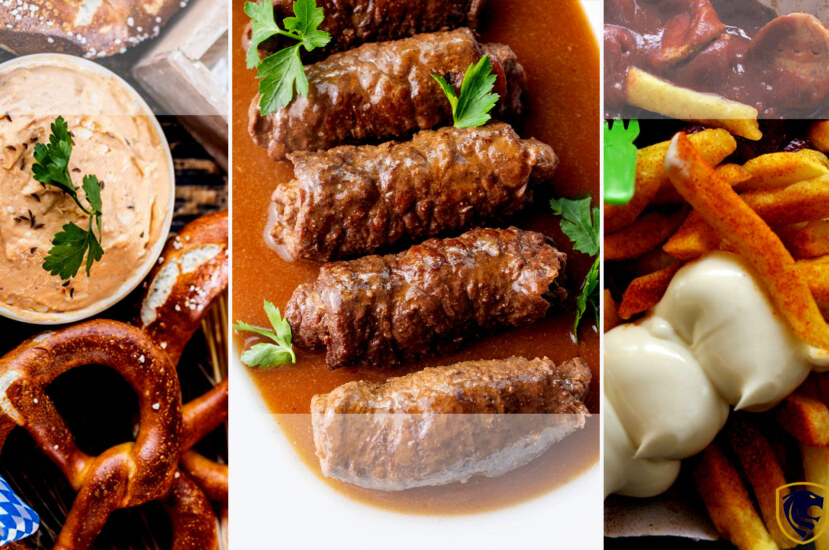Germany might not be the first place that comes to your mind whenever you are thinking about traditional food. But Germany is home to many mouth-watering traditional dishes. Let’s explore the best of it.
Königsberger klopse
It is a widely known reality that Germans like beef. The one thing they cherish the most and are most proud of is meat, which they used as the subject of songs, parables, and stories.
Meat preparation and consumption have a long history in Germany. The Königsberger Klopse originated as a delicacy from the formerly powerful Prussian Empire. It was given that name in honor of Königsberg which is a city that was destroyed during World War II. After the Russians took control of the city, they changed its name to Kaliningrad. The dish’s name was changed to Kochklopse when the German Democratic Republic was established. When translated, kochklopse means boiling meatballs.

Mouth-Watering German Dishes; Königsberger klopse
The recipe for Königsberger Klopse was created when ground beef was first introduced to the German diet 200 years ago. The identical dish may also be found in several parts of Germany and throughout Europe with a few minor modifications. The original version of the dish called for thin strips of beef comparable to the Wiener Schnitzel. In the past, it was prepared with sour and creamy sauces. It is said that a cook who belonged to one of the commercial families in Königsberg is where it officially began. Since then, Königsberger Klopse has evolved into a traditional German dish offered on a variety of special occasions.
Sauerbraten
If you’re not a vegetarian or vegan, you should try some sauerbraten when you visit Germany. Sauerbraten is regarded as the national dish of Germany.

Mouth-Watering German Dishes; Sauerbraten
It requires a significant amount of time to prepare this meal. Yet no dish reflects a traditional German dish more than Sauerbraten. You will have an incredibly delicious flavor since it is composed of beef that has been roasted gently in the oven for hours.
Typically, sauerbraten is served with Rotkohl which is red cabbage. Also, it can be combined with spätzle, boiled potatoes, and sauce.
Potato Fritters or Potato Pancakes
Germany is one of several Eastern European nations that makes its kind of potato pancakes. You can easily make this kartoffelpuffer, also known as German potato pancakes, at home. The golden, crispy fried pancakes are a wonderful treat. Moreover, it pairs nicely with homemade applesauce or sour cream to reduce oiliness.

Mouth-Watering German Dishes; Potato Fritters or Potato Pancakes
Germans eat freshly cooked potato pancakes with applesauce at local outdoor weekly markets, Christmas markets, or at Karneval or Fasching. As a side dish, these potato pancakes go well with meats like roasted chicken or pork. Also, this dish can be offered as an appetizer or as part of a delightful supper. In addition, it can be topped with fruits. Kartoffelpuffer is particularly excellent for breakfast.
Currywurst
Herta Heuwer, a German housewife, was searching for a way to spice up her boring post-war diet. One day in Berlin in 1949 s he acquired some ketchup and curry powder through some cunning dealing with British soldiers. Then she combined those with fresh peppers, paprika, and other spices. The Currywurst was created when she poured everything over a fried and sliced boiled sausage.

Mouth-Watering German Dishes; Currywurst
Her spicy, sweet sausages were a huge success. Soon, they were flying off the shelves at her modest street corner for 60 Pfennig each, or around 30 cents in modern currency. Moreover, she launched a permanent snack café on Kantstraße a few years later. While many other sellers were attempting to replicate her recipe, they were never able to access her secret currywurst formula.
Schnitzel
The German schnitzel, which is now a cornerstone in most traditional restaurants, is made with tenderized pig or turkey. But the Austrian or Vienna schnitzel must be made with veal.

Mouth-Watering German Dishes; Schnitzel
Germans adore spreading sauces over their schnitzel, whilst Austrians prefer theirs plain. A creamy sauce is provided with rahmschnitzel, whereas zigeunerschnitzel is served with bell pepper sauce and jagerschnitzel is served with mushroom sauce.
Brezel
Pretzels are baked pastries that are shaped like knots and are known as “bretzel” or “brezel” in German. Depending on the type of dough used, pretzels come in both sweet and salty varieties. Nonetheless, the conventional German pretzel is salty and enhanced by lye treatment, giving the pastry its renowned tanned exterior and flavor.
Germany’s southern regions, particularly Bavaria and Swabia, are where it is most popular. The normal Swabian pretzel differs from the Bavarian pretzel. Bavarian pretzel is typically thicker, in terms of the thickness of its threads.

Mouth-Watering German Dishes; Brezel
Particularly smaller kids love this snack. Because they are mess-free and simple to grasp while eating.
You might definitely argue that having a preference for pretzels isn’t really an option for Germans. Germany just has become adapted to it since they began eating solid meals.
Rouladen
Every German bakery sells pretzels. Moreover, some cities, particularly in Bavaria, even have pretzel stalls set up outside marketplaces or railway stations.
In Germany, rouladen is a traditional and adored dish. Although the dish’s actual history is uncertain. It is known that it originated in Europe. Also, the name “roulade” comes from the French verb “rouler,” which means “to roll.” Rouladen used to be served only on Sundays or on special occasions since it was regarded as being so special. These are now a common option for supper in Germany. Moreover, it is available every day of the week and throughout the year. But notably in the fall and winter. Being a casual comfort dish for the chilly German winters, rouladen is quite popular. The roulade is sometimes referred to as “beef olive” in various nations.

Rouladen
Although some culinary experts think that the original meat was probably deer or hog, which is still popular in some regions, beef or veal is used nowadays to prepare this dish. Throughout the past century, beef Rouladen has evolved into what we know today. Although this is the less expensive cut, topside or silverside beef is typically used. The round steak, sometimes referred to as rump steak, is the more costly option. The meat is divided into thick, broad pieces to gain the perfect Rouladen dish.




